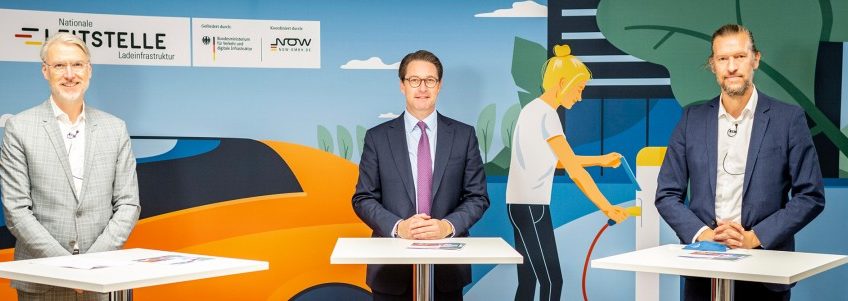Berlin, 6 October 2020 – Andreas Scheuer, Federal Minister of Transport and Digital Infrastructure, together with Kurt-Christoph von Knobelsdorff, Managing Director (Chair) of NOW GmbH, today officially launched the operating phase of the German National Centre for Charging Infrastructure. Speaking on location, Johannes Pallasch and Dagmar Fehler (Heads of Centre), outlined the status of the developments and presented the Federal Minister with the Centre’s first paper „Einfach laden“ („Charging simply“).
The objectives of the Centre include:
- The expansion of a public fast-charging network with 1000 locations by the end of 2023, covering charging needs during extended journeys and in day-to-day situations in urban areas.
- The installation of 50,000 publicly accessible fast and normal charging points by the end of 2021.
- Acceleration of the development of private charging infrastructure through financial support and improved legal framework conditions.
- A user-friendly public charging infrastructure with easy-to-find charging points that function reliably and invoice the charging process transparently using common payment methods.
In November 2019, the German government agreed on these goals and the establishment of a National Centre for Charging Infrastructure in the “Charging Infrastructure Master Plan”. The Centre will act as a central point of contact on the subject of charging infrastructure for the federal government and all its departments.
Kurt-Christoph von Knobelsdorff, Managing Director (Chair) of NOW GmbH: “The federal government has pledged to reduce greenhouse gas emissions in Germany by a total of 55 to 56% by 2030 compared to the levels of 1990. In order to achieve this, road traffic must be ‘electrified’ swiftly. The latest electric car registration figures show that the people of Germany are ready for this. But what is still missing is a good charging infrastructure. That is what we are fighting for. Under the umbrella of the federally owned NOW GmbH, the National Centre for Charging Infrastructure is pressing ahead to ensure its rapid development.”
Johannes Pallasch, Head of the National Centre Charging Infrastructure: “Charging simply. That is what we are working on. We are coordinating and managing the activities for the expansion of the charging infrastructure in Germany. We support planning and implementation and promote the development of charging infrastructure. We collect relevant data to gain a better understanding of the needs for further charging points. We network the key players such as operators of charging infrastructure, automobile manufacturers, federal states and municipalities, and share our knowledge. And we always have the users in mind. It is their satisfaction that motivates us.”
StandortTOOL (location tool): Knowing the demand and planning accordingly
With the StandortTOOL (location tool), the National Centre for Charging Infrastructure has a planning tool at its disposal that enables it to plan the charging infrastructure for cars throughout Germany up to the year 2030 and to calculate the further expansion requirements. The StandortTOOL (www.standortTool.de) shows the future need for additional charging points and takes into account traffic flows, socio-economic data, vehicle numbers and existing charging infrastructure. In addition to the charging infrastructure for battery vehicles, the planning of the demand-oriented expansion of the hydrogen (H2) filling station network has also been possible since June 2020. Infrastructure planning for the commercial vehicle sector (battery and hydrogen) is envisaged for the future.
FlächenTOOL (plot tool): Bringing together landowners and investors
With the FlächenTOOL (plot tool), the National Centre for Charging Infrastructure is creating a digital platform to provide an overview of potential plots in Germany that are suitable for the development of necessary charging infrastructure and to bring the owners of such plots and investors together. The first version of the FlächenTOOL is scheduled to go online at the end of 2020.
Paradigm shift in financing: Funding and tendering
Charging infrastructure consists of a comprehensive system of public and private fast and normal charging options. Here, the National Centre for Charging Infrastructure is working on improvements in several areas simultaneously:
- 1000-site programme / fast-charging network: To meet the demand for medium and long-distance mobility on major roads, the federal government will put a nationwide fast-charging network (at least 150 kW capacity per charging point) comprising 1000 sites, out to tender. This will enable batteries to be sufficiently charged quickly on longer journeys or in densely populated areas.
- Private charging infrastructure funding guideline: From November 2020, the federal government will facilitate the funding of private charging stations for homeowners and tenants. This is being undertaken as the majority of charging processes in the medium term will not be conducted in public places.
- Public charging infrastructure funding guideline: After six calls for funding, the current public charging infrastructure funding guideline of the BMVI ends in 2020 with a total funding volume of 300 million euros. The approval of the last applications is in progress. Preparations are currently underway for a new Public Charging Infrastructure funding guideline, which is to be introduced in 2021.
Know-how: Standardising the technology
The National Centre for Charging Infrastructure will work on standardising the technology employed for charging vehicles and subsequent payment, in order to improve the aspect of user convenience.
- Roaming: Users who have signed a contract with a particular mobility power provider for charging their electric car should also be able to use the charging points of other providers without encountering problems.
- Calibration regulations: The National Centre for Charging Infrastructure will provide information to persons and institutions wishing to set up a charging infrastructure, regarding the legal situation and potential solutions for metering the quantity of energy delivered during the charging process.
Monitoring and analysis: Maintaining an overview
The National Centre for Charging Infrastructure has been conceived as a pool of knowledge relating to all aspects of charging infrastructure. It is here that reliable scientific, technical and business intelligence on charging infrastructure is gathered. Where this knowledge is not yet available, the Centre will acquire it through its own studies. This serves, among other things, to ensure an even more efficient and targeted implementation of support measures for charging infrastructure, such as in demand planning, for example. To compile operating and master data, the Centre uses the “OBELIS” online platform (“Online-Berichterstattung Ladeinfrastruktur”, in English: “online reporting of charging infrastructure”), which has been set up specifically for this purpose. This data shows, for example, that an average charging process takes five hours at a normal charging point and 45 minutes at a fast charging point. The data is made available for analysis by the German federal government.


